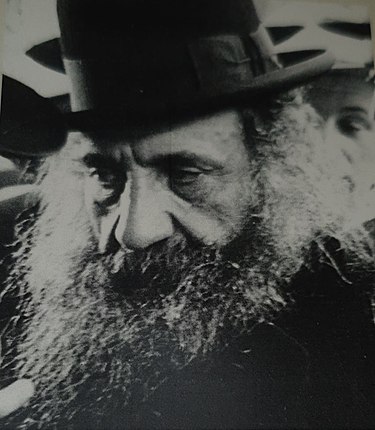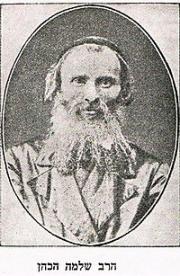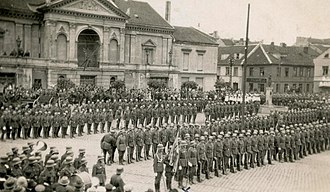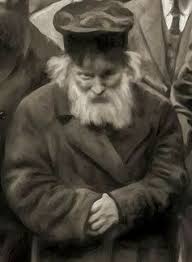| | FEATURE
"You went after me in a desert, an unsown wasteland" (Isaiah)
The story of HaRav Moshe Yehuda Schneider, zt'l, rosh yeshivas Toras Emes in Memel, Frankfurt, and London
by M. Samsonowitz

This major series of articles about the heroic rosh yeshiva HaRav Moshe Schneider whose talmidim, both Ashkenaz and Sephardic, went on to great achievements, was first published in 1994.
Part I
For Part II of this series click here.
If in heaven they have a special department for those courageous Torah disseminators who established yeshivos in spiritually empty vicinities against mighty odds, Rav Schneider will have an eminent place there.
And if there is a special department for the brave-souled who cried out, "Give me Yavne and her wise men!" at a time of bitter destruction — Rav Schneider will have a distinguished spot there.
And if there is a special department for those who revived Torah study at a time when it was almost lost and forgotten—Rav Schneider will be in the front row there too.
Rav Schneider was truly among the main disseminators of Torah in the last century. An unusual and dynamic individual who transplanted Torah and made it flourish in spiritual wastelands where no one believed it was possible, he did the painstaking groundwork that enabled the barren atmosphere in England and France to give way to the dozens of yeshivos, religious institutions and frum communities that are in existence today.
HaRav Schneider was a man whose entire focus was in the yeshivos which he established, and in his love for Torah, for which he lived. He was not well-known in the various cities where he resided, and, in keeping with his modest personality, his accomplishments for Torah were not fully appreciated in his lifetime. But the love for Torah and mussar which he instilled in his students produced mighty talmidim who changed the face of postwar European Jewry.
He erected his yeshivos in places that defied logic. When his yeshiva was forced to disband or close, he tirelessly set it up again somewhere else. His institutions seem a bit like a house of cards that collapses again and again, but his reservoirs of bitochon and mesiras nefesh stood him in good stead to mobilize his next initiative.
Growing Up In Lithuania
Rav Schneider, or the "Rebbe" as he was called by his students, was born in 1885 in the town of Zhivenishok near Lida in the Vilna district, to a family of bnei Torah businessmen. His mother was the sixth generation from R' Eizik Slonim, one of the disciples of the Vilna Gaon, and he was a relation of Reb Boruch Ber Lebovitz, the rosh yeshiva in Kaminetz.
His parents provided him with the best melamdim in the town, and they urged him to invest his utmost into Torah study. Rav Schneider would fondly recall how his father would lift him up so he could see the town's rav, and then whisper in his ear, "Do you see the rav, how distinguished he is? You can also be like him!"

At age 13 he went to Vilna to learn under the famous Rav Shlomo Cohen, one of Vilna's dayanim. His schedule of learning included 3 hour long sedorim each day including Shabbos, with strict examinations every week. After Vilna, young Moshe Yehuda went to learn in the Slobodke yeshiva for a short time. He then joined a kibbutz learning in the town of Veranova for five years, maintaining himself by eating "teg" in various homes. He was known for his great enthusiasm and diligence in learning, which invigorated the entire group.
During those years he became acquainted with the Chofetz Chaim — whom he was quickly drawn to — and began to visit him regularly. He was wont to write the Chofetz Chaim asking for personal advice in avodas Hashem. Until the end of his life, Rav Schneider held himself to be a disciple of the Chofetz Chaim, and he frequently would quote his teachings in both mussar and halacha. The Chofetz Chaim was very close with Moshe Yehuda, and he felt that he would be a great power in Germany.
When the Russo-Japanese War broke out in 1905, and he saw that he would not be able to gain an exemption from the army, he changed his name and moved to Marenbruk, near the German border. He hid his identity even from other Jews, since there was always danger from informers. He even changed the name he used when being called up for an aliya. One day, however, a townsman came to Marenbruk, recognized him, and called him by his real name. That day he fled across the border, to the German city Memel.
A scene in Memel in 1923

Living In Memel
Memel had, even 50 years before, been one of the secularized Jewish communities which HaRav Yisroel Salanter attempted to draw back to the wellsprings of Torah. In 1905, the spiritual scene was as discouraging as ever. Now Memel is known as Klaipeda in Lithuania.S
The German Jews who lived there were far from Torah observance, but there was also a small Russian Jewish community which had its own rav. Many of the members of this community were wealthy Jews who owned large tracts of forest. Some of them were Torah scholars themselves, but they all sent their children to study in the local non-Jewish "gymnasium."
At first, Moshe Yehuda planned to study Yoreh Deah, and then get a rabbinical position in America. But when he came to study in the beis hamedrash, he found a group of young men, draft-dodgers like himself, who were trying to figure out what to do with their lives. When he sat down to learn, they ridiculed him—"Is this the time and place to sit and learn?"—but when he ignored their sharp words and continued to learn, they became ashamed and sat down to join him.
His diligence was amazing during this tumultuous period. Besides the rigidly-fixed time he set aside for tutoring students—which provided him with his basic sustenance—he spent his entire time in devoted Torah study. His intense devotion to Torah study brought on illness which ravaged his health, and he was forced to stop his study for a period of time. As a result, he resolved to take a half hour of exercise each day—a resolve he usually fulfilled by walking in a nearby park or woods while looking in a sefer.
At this point in his life, Moshe Yehuda had not yet become inflamed by mussar. But in Memel he met an unusual man who was a harmonious combination of several opposing systems of thought. This man was known in Memel as the "Black Ascetic" (Porush Shochor). He was a Chabad chassid who, like other chassidim, would travel to his rebbe for chassidic inspiration. But he was also a mussar personality who would just as much travel to great baalei mussar for mussar inspiration.
He was considered not only a fanatic, but also a bit strange. For instance, he would commit himself to learn a certain number of hours at a stretch. If he was interrupted, he would readjust his watch to the time he was interrupted, and continue learning until the set period of time was completed.
The young Moshe Yehuda fathomed that this unusual man was a personage from whom he could get direction and inspiration. The first tangible insight that he received from this man was a love for mussar.
Under the man's direction, Moshe Yehuda found a new world in the sefer Chovos Halevovos, which shortly became a beloved companion to him. Indeed, until the end of his life, HaRav Schneider was greatly attached to this sefer, and most of his hours spent in mussar study were spent poring over its pages. When later in life HaRav Schneider suffered physical weakness or moments of difficulty, this sefer was the panacea which left him invigorated with bitochon and courage.
That ascetic influenced him in another major way: by inspiring him to use his powers to benefit society. He learned to view his students through a different perspective. Instead of making do with merely fulfilling his teaching obligations to them, he was now fired up to draw them into the world of Torah study, to live the Torah's values. He convinced a number of his students—who had been attending a German high school—to attend yeshivos despite their parents opposition. Years later, even when he himself was living in substandard conditions, he would still send these students money to provide for their needs.
During this period, Moshe Yehuda learned bechavrusa with a close friend, R' Elya Shapira. The young bochurim maintained an unusual seder: they would learn two new pages of gemora, and the next day they would review these pages and learn two more. Every day they would keep reviewing the pages they had learned until they had learned each page twenty times! In this way, the two finished several masechtos and the entire Yoreh Deah.
Founding A Yeshiva In Memel
At the end of this period, Moshe Yehuda began to think of establishing a yeshiva. By this time, he had become a presence in Memel, and at his initiative, several improvements were instituted in the Jewish community in Memel.
For instance, it was a common practice for the baalebatim to converse during krias haTorah in shul. One day young R' Schneider banged on the bimah with force, until the baal koreh was forced to stop reading.
He then cried, "Is this a marketplace! Are we selling merchandise here!"
He called out sharply in this fashion, without taking any notice of the worshipers who were trying to shush him. In the presence of his sharp words of truth, the worshipers had no choice but to abandon their time-worn "minhag."
Another time he became involved in the case of a Russian gentile who wanted to convert to Judaism. Although the gentile's intentions were lesheim Shomayim, and he had already begun to fulfill mitzvos and learn Torah, the official rabbi kept pushing off his conversion under the ostensible reason that "it will increase antisemitism in the city."
Rav Schneider wasted no time to help the deserving man. He went to a nearby village, hired a room and brought a Jewish doctor to perform the circumcision on the ger. Once this part of the ceremony was a fait accompli, the local rabbi had no choice but to complete the conversion.
It made no difference to the single-minded young Moshe Yehuda that his competence and dynamism were developing him adversaries. He soon became a target of some who didn't appreciate his bold approach. Some of them fomented a plan to slander the troublemaker to the police, smug in the knowledge that he would be quickly dispatched for living on German soil without a permit.
To his rescue came a simple butcher, who admired him and had joined him in several of his projects. This man went to the ringleader of the slanderers with his chopping knife and told him grimly that he is reserving this tool to do justice to informers. The slanderers backed off from their scheme.
At this time, as a result of reproof from the ascetic, Moshe Yehuda grew a beard — even though it was uncommon for Litvishe bochurim of his age to sport one. For the rest of his life, he lamented the fact that most yeshiva bochurim shave and he urged all of his talmidim to grow a beard.
Finally, R' Moshe Yehuda laid plans to found a Litvish-style yeshiva in Memel. However, the very mention of the idea brought a smile to everyone's lips. It was a good joke, but nothing more.
In fact, it was ludicrous! Who would come to a Litvish-style yeshiva? German boys wouldn't be interested, and if a few could be ferreted from somewhere who would possibly be interested, it was foregone that their parents would oppose their decision. Russian youths wouldn't come because they couldn't get an entry permit to Germany. And who would support the yeshiva? Even his best friend Elya Shapira ruefully admitted that the idea flew in the face of all reason.
But "impossible" was a word that didn't exist in R' Moshe Yehuda Schneider's vocabulary. He began to lay the groundwork for founding the yeshiva. It was at that point that it became clear to him that he needed an eizer kenegdo, and that without one, he couldn't carry out his plans. He was already 27.
The Chofetz Chaim

Finding A One-of-a-Kind Wife
What kind of woman would be prepared for the life of mesiras nefesh that his goals dictated? From where would he find the idealistic wife to share his devotion to the preeminence of Torah study and its dissemination?
It was no simple matter in those days. Finding a wife like that was at least as hard as founding a yeshiva in Memel. HaRav Chaim Ozer Grodzensky, the rav of Vilna and president of Vaad Hayeshivos, who lived at the nerve center of the yeshiva world, once commented wryly that if one sees a crippled woman, one should stand up for her, because undoubtedly she is the wife of some great Torah scholar. These were the only kind of wives that brilliant Torah scholars could find to share a life of idealism and deprivation with them in those days.
R' Moshe Yehuda Schneider sent letters to all his friends asking if they knew of a woman, the daughter of a talmid chochom, who would be suitable for him. A dowry was not important, but she would have to undertake to cook for the talmidim in his yeshiva.
This was a total innovation for those days. Until that time, yeshivas had not maintained kitchens. Instead, the bochurim ate their meals every day at a different home, or, if they were lucky, they would take their meals every day at the same home. Since when did the rosh yeshiva's wife have to undertake the role of the cook?
But R' Moshe Yehuda Schneider, an original thinker, had carefully thought out the plan of his yeshiva. For one thing, a yeshiva has to develop a bochur and make him into a new creation. He knew that Germany was a land of chilly formality, where physical comfort and prosperity is the sine qua non, and where spiritual concerns are viewed as a yoke to be dispensed with as fast as possible.
In such a spiritually sparse region the only way for a yeshiva to succeed in its task at remaking bochurim in the mold of Torah was by creating for itself a lush island in the spiritual desert. This could only be done if the bochur's complete needs, including room and board, were provided by the yeshiva.
A second reason for his policy was practical: He knew it would be difficult to cover the expenses of the yeshiva. He wouldn't easily find supporters in a German city. Nor were there likely to be baalebatim who appreciated the yeshiva enough to suffer the humiliation of collecting for it. Every expense that could be trimmed down—including labor—would remove part of the burden of maintaining the yeshiva.
His attitude of keeping the material needs of the yeshiva to a minimum became a cornerstone in his philosophy. Although it discouraged the attendance of boys from well-to-do or baalebatish homes, it did not put off boys from less comfortable homes who gathered around him, attracted to the honest and passionate example that he set, and whom he was able to build into sterling bnei Torah.
The days passed and R' Moshe Yehuda Schneider waited in vain for a positive reply to his query. Finally a letter arrived from the Chofetz Chaim's son-in-law, Reb Hirsch Levinson. He wrote in his father-in-law's name that right in Radin there was a suitable girl for him. She was the daughter of Reb Gedaliah Kaplan, z'l, one of Radin's worthy Jews who had been a devoted friend of the Chofetz Chaim.
Reb Gedaliah was a lover of Torah to the point of self-sacrifice. Instead of allowing the yeshiva bochurim to suffer the humiliation of knocking on doors and asking for their daily fare, Reb Gedaliah undertook to do this demeaning job himself. Hanging the bochurim's small pots from his belt, he knocked on each householder's door and asked for a contribution to sustain Radin's Torah students. When the pots had been filled, he returned to the bochurim who were grateful for being spared the time and humiliation that he had sustained for their sake.
Reb Gedaliah had passed away young, leaving only a young daughter to say kaddish on his behalf. The Chofetz Chaim had been a surrogate father to this young girl, who had in the meantime come of age. When he proposed a shidduch with Moshe Yehuda to her, the young woman agreed to his conditions. She shared his love of Torah and was inspired to join him in becoming an architect of Torah.
How could such a wonderful match come off without obstacles? The young man's parents were dubious about the match. Their son was an eminent Torah scholar and a shining personality, a person whose future as a leader in Klal Yisroel was bright. He was good-looking and made a powerful impression on all who met him. But who was being suggested for him? As far as they could see, the girl was just an orphan from a plain home, who wasn't even bringing a minimal dowry.
They didn't realize how removed Moshe Yehuda was from typical societal conventions. He had his own supra-worldly set of standards that necessitated a unique kind of wife.
The Chofetz Chaim became intensely involved in the delicate negotiations that the situation necessitated. The parents' doubts had to be overcome, a feat which became even stickier when the young kallah contracted typhus shortly before the wedding. Convincing alibis had to be found to push off the wedding date until the kallah was strong enough to attend. Although it was his practice not to be mesader kiddushin in place of a town's rav, in this case, due to the exceptional circumstances, the Chofetz Chaim made an exception.
During the wedding, the Chofetz Chaim called Moshe Yehuda aside and whispered in his ear, "One must make sure there is parnossa too."
Recognizing the young man's devotion to Torah study, the Chofetz Chaim knew that if there would be any margin of error, it would be for Torah study instead of a livelihood.
In retrospect, it can be stated clearly that R' Moshe Yehuda acquired a shining diamond. His wife, Yehudis, will go down as one of the greatest woman in Jewish history. She faithfully fulfilled her promise to her husband, and through the many stages that his yeshiva underwent, she was always at his side undertaking a great portion of the burden by physically nurturing the yeshiva. She was the cook of the yeshiva for over 40 years of her life, often rising early at 6:00 a.m. to prepare coffee for the bochurim.
She willingly made her family life subservient to the needs of her husband's yeshiva. Of the tremendous growth of Torah communities in England and Europe after the war, one can truly say, "Mine and yours —it is all hers!"
End of Part I
|




